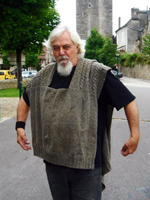
Optics have been mystifying all of us since the 15th century. In an illuminating book called Secret Knowledge (there’s also a BBC series), David Hockney investigates a hunch that, down the centuries, the abilities of hundreds of artists in the small matter of draftsmanship has something very strange about it.
With a team of friends and assistants he reviewed and analysed thousands of celebrated European paintings all the way back to the 14th century and earlier. In a style of presentation that is both relaxed and laconic, he observes (rather sarcastically and with a touch of indignation) that around 1420 “… suddenly everyone could draw virtually faultlessly.”
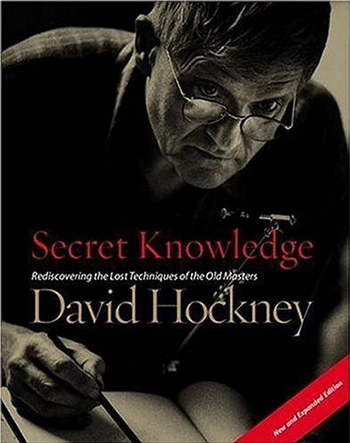
For instance he noticed ultra-realism in depiction of faces, characters and details; perfect rendering of perspective; specular reflections on armour; silk cloth depicted immaculately, and so on.
To summarize a long and wonderful investigative journey, after observing that most subjects were invariably bathed in bright sunlight (and that several figures were performing too many left-handed operations and gestures) and even that some parts of a painting might actually be out of focus (?!), Hockney concluded that these paintings were in fact quite simply copied from nature.
By using a small spoon-like mirror, the images of staged scenes were projected onto the wall of a darkened room — literally the camera obscura, a camera being simply a pin-hole camera, writ large. Artists composed scenes with models, decor, props and details as required and, seated inside the improvised camera obscura, merely traced and copied the projected image.
Hockney set about proving this theory with the help of mathematicians, with practical recreations of the scenes depicted in various famous paintings — and with computer analysis and simulation.
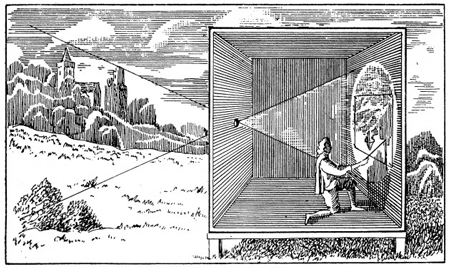
A historical overview confirmed that from around 1420 lenses were used instead of the mirror, thus offering more variation.
For obvious reasons artists kept their techniques secret and, remarkably, according to Hockney and his team, no art historian has ever guessed-at, or posited this “copying” technique as a likely explanation for patent realism.
Incidentally, Hockney talks of these artists as literally drawing — copying or tracing — inside the camera obscura. Later, in referring to photography per se, he cites the discovery of the chemical processes which fixed the image, entirely, without the intervention of the artist’s hand — though initially only in tones of black and white.
Were these artists then essentially proto-photographers? Paintographers? Graphartists? Photartists?
It’s a troubling blurring of boundaries. First, these “copyists” were literally working mechanically, in the dark: the ethereal projected image had to be faithfully reproduced, or — verbatim — “traced,” because the darkness precluded any artistic license, any interpretation, since adequate visibility is essential for basic co-ordination of hand and eye.
The image resulting from the copying could only be seen clearly either by artificially illuminating the support on which the artist was working (thus momentarily banishing the ethereal projected image) or out in the full light of day, where some modification could take place.
Of course the “artist” was responsible for the creation of the tableaux that he assembled in front of the lens, so that a degree of plastic expression is incontestable. And many of these neo-realist paintings do involve wonderfully complex and deeply satisfying compositions, but their power seems derived principally from being so close to realism.
Hockney does elucidate a few such paintings in which the artist had obviously attempted a kind of “cut and paste” technique: adding figures from different sittings to produce group compositions. Seldom seamlessly however, the insertions were being betrayed by size and perspective problems.
Another question: if so many illustrious artists shamelessly resorted to the irreproachable proficiency of the optical approach in creating their works, why the stress laid on draftsmanship — before and since?
Art teachers have for generations insisted rigorously on the need for students to acquire the complex ability to “draw”: to be able to reproduce, reasonably faithfully, at a distance, the elements, dimensions, proportions and positioning in 3D space perspective of any object, involving highlights and shadows and so on.
Historians too have emphasised the inherent importance of draftsmanship as qualitatively determinant in their ruminations, lauding the pictorial and formal sophistication that is to be found at the opposite end of the continuum from “the naive,” the amateur, the unlettered, the untrained.
It is true though that the notion of draftsmanship extends from the unique ability first to “appropriate” the real world, and then to “intervene,” to interpret, to alter, to distort, to introduce subtle shiftings from the visible truth which make for a wholly individual vision, charged with a particular life-view, be it experiential, personal, historical, crucial.
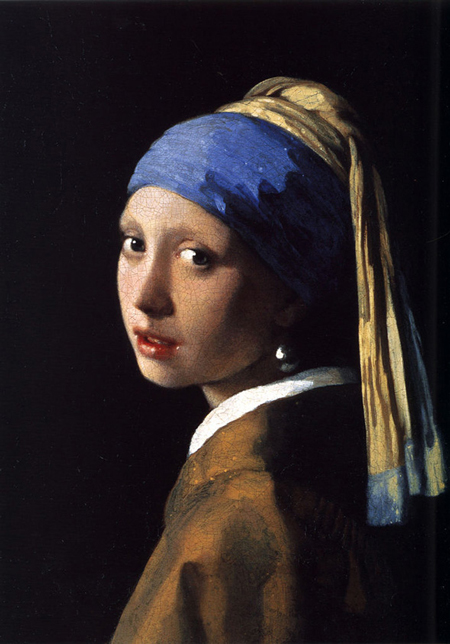
Because the general scope and notion of art and artistic expression — and especially that of contemporary art — has widened and deepened considerably (or at least altered substantially), this discussion is a little like looking down the wrong end of a telescope. Yet Hockney’s discovery is intriguing.
In the course of the filming of the BBC series Hockney bases much of his investigation on the work of Vermeer, the clarity, detail and realism of which is so blatant.
At one point — by assuming that Vermeer did in fact resort to a lens to produce the celebrated painting of the young girl with earring — Hockney calculates that from the dimensions of the actual room in which the scene was set, and given the optical strength of the lens used, that the resulting image projected on the rear wall of Vermeer’s studio would necessarily have to be a specific dimension.
And yes, it happens that the size of the painting matches exactly the dimensions of this theoretically contrived and projected image. So the question arises:
Are we to consider that these artists were actually cheating? And that their secrecy was as much an admission of guilt as it was a matter of protecting the tools and techniques of their trade?
A curious and ironic sub-theme here is the naive and persistent insistence — largely on the part of a popular audience, admittedly — that the artist’s role is in some way mainly evidential, documentary: that his principal task is to produce a likeness, a kind of pictorial facsimile, in memoriam.
This “prerequisite” may well date from a pre-photographic era, when the ability of an artist to create an image ressembling its subject was a first principle, and must have seemed astonishing to viewers, to the point of being almost magical. Witness cave art…
We are unable now to fully appreciate the power and significance of this impact, we who are so familiar with (and immunized by) the recorded photographic image of virtually all aspects of our physical world.
In retrospect one must consider that there was surely a subconscious, compulsive and collective longing for and momentum towards the discovery of photography: and because it did not then exist it was essential to invent it.
Is photography truth or fiction?
From a viewpoint further along in time, and given an altered perspective, the ubiquitous presence of secular photography, in all aspects of our daily lives, tends to inure us to the power of photographic images that are made for purely aesthetic purposes. Or for that matter to images which, by chance or accident — or even because of the simple passage of time — achieve that quality, that state of grace, which we recognize intrinsically as “art.”
In reality, photography, as medium, does indeed have this peculiar ambiguity and duality about it: photographic images are both fact and fiction, simultaneously.
“Fact” in that photographs (ostensibly, reputedly, allegedly) transcribe facts.
But “fiction” because those facts are always somehow slanted, have a particular “spin” to them, are covered with smudgy fingerprints. For instance, a straight record portrait of the same person by different photographers, each provided with entirely uniform equipment, will produce wholly different results — for all sorts of reasons: the differing human relational rapport established between subject and recorder being the least amongst them.
In the face of the overwhelming evidence provided by so-called pure or straight documentary photography — however neutral, descriptive, evidential — we are forced to concede that the actual subject remains somehow ephemeral, elusive and imprecise because it is so endlessly variable.
And it is variable exactly because the act of photographing inadvertently provides the image-maker with an infinite variety of ways in which to record a subject, despite the ostensibly neutral optical-chemical recording facility.
Accomplished photographers (and even untrained, inexperienced folk who casually happen to make photographs haphazardly) develop their own inimitable way of recording an image and of using photography in a highly personal fashion. Yet much more important is that in exactly the same way that Hockney’s proto-artist used optically projected images (doctored or concocted in some way), so too the accomplished photographer has access to a wide range of manipulative techniques for forming his images — before, during and after the fact of exposing the film.
This pinpoints the essential similarity between the artistic impulse as it is given form by artists in other media.
In fact there is no photography without inherent manipulative techniques. These are as limitless as are artistic imagination, ingenuity, resourcefulness, pain, joy as well as basic and ineffable expressive need (plus everything else).
As in all media, the means are found that correspond to, and respond to, the basic driving force, and in general involve choice of tools, materials and supports; choices which are always subordinate (when pure accident or chance is not encouraged) to a broad array of artistically and intellectually determined factors — such as selection, framing (inclusion / exclusion), timing, juxtaposition, sequencing, thematic groupings and so on.
For instance, in purely optical terms, the choice of the camera and the focal length of the lens can introduce spatial distortion — subtle or exaggerated – at will. (To simplify, wide angle lenses expand spatial depth, while telephoto lenses compress it.
Then factors like choice of film, filters, light / lighting — through materials and “supports” such as printing papers, projected images / transparencies, video — are all crucially important elements providing an infinite degree of expressive license to the photographer.
Not to mention the relatively recent addition of digital image recording and manipulation which has resulted in an exponential leap, at least in terms of proficiency and sheer productivity.
So how to evaluate photographs?
An apparent problem for art critics, historians, curators and others, when faced with photographs, is the assumption that a good technical knowledge of the science of photography is indispensable. Though some technical knowledge may contribute to a clearer understanding of the photograph, this is at best tangential, missing the point:
Walker Evans, on being asked what camera he had used for a particular image, responded with pique that it would be unthinkable to ask a writer what typewriter he used… What a good opportunity to denounce the pernicious and persistent misconception, promoted by those with commercial interests, that “new, improved” equipment will automatically produce better and more valuable images!
And what about knowledge of the history of photography as an art form?
This is a house that is best built slowly, empirically, cumulatively, comparitively; though even a brief survey of the major collections and the burgeoning literature of photography will testify to the extraordinary range and reach of those photographers with special vision.
Yet like all art forms, in the attempt at decryption, powerful photographs too are intrinsically untranslatable, though at first glance there may seem to be rather less that is inaccessible, in that we are faced with real forms frozen in time, like rubbings taken from the surfaces of the world.
The danger however is to avoid confusing content and form, or content with substance: some photographs may properly belong in museums and archives rather than in the art gallery, even though the content may be momentous.
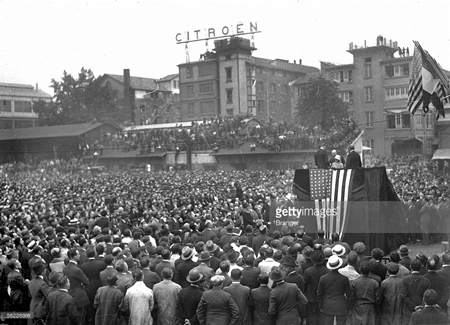
The sweeping photograph of Lindbergh addressing a vast crowd in the Citroën factory in Paris following his solo flight across the Atlantic is undoubtedly significant as history, but whether it could also be significant as art depends entirely on the sensibility of the photographer.
And “sensibility” is a big word — is shorthand for all that signifies the intrinsic consciousness of an artist.
I have a panoramic photograph of Cape Town, made in four parts somewhere in the 19th century; it records the full sweep from Devil’s Peak across the slopes of Table Mountain to Lion’s Head. Recorded on 11×14″ glass plate negatives, its purpose is plainly and exquisitely documentary, though it happens to provoke a sensation of awe and delight, in being complex, and balanced, and strangely definitive, unquestionable.
It is a kind of proclamation, because the photographer, though he remains anonymous, was necessarily and profoundly of the world, and in it — as well as in, and of, his time.
Made with a precision instrument and with painstaking technique, it is a love poem as deep as it is wide, as well as a poignant relic, and is as precise, profound and complex as a math formula.
The finest photographs embody a unique visual language and expose a new universe which is expanding, vibrant, vital and provocative.
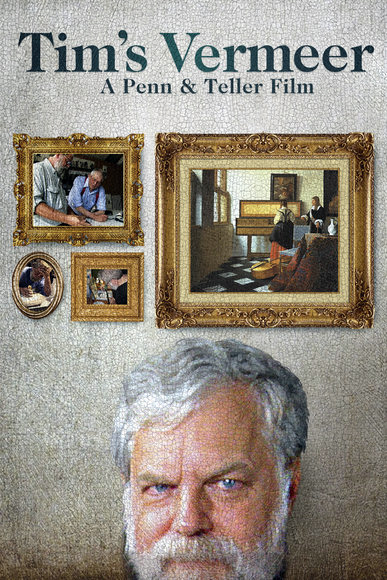
It matters little that the process is mechanical: a pencil and a violin are no less so.
In his journey of discovery, which is truly remarkable and original in its own right, Hockney knows this — not academically, not intellectually, nor from any partisan position, but thanks to an insider’s understanding of the qualitative essence of art objects — all art objects — which are imbued with and pronounce their own significance and value, for those within hearing.
What an irony though: I remember reading that at art school Hockney’s weakest subject was in fact life drawing — or draftsmanship. And that he literally taught himself to draw by closely studying comics, learning from their essentially reductive simplicity.
He seemed to know that drawing was merely a means to an end, as would be his use of photographs later.
As for Vermeer?
His paintings might be a sort of 350-year-old color photographs.
Doesn’t make Vermeer a fraud. Yet he might have saved himself a great deal of trouble if the Polaroid camera had been invented.


